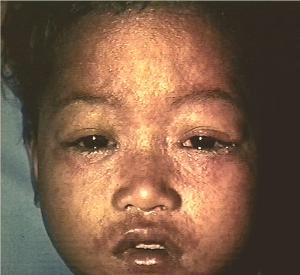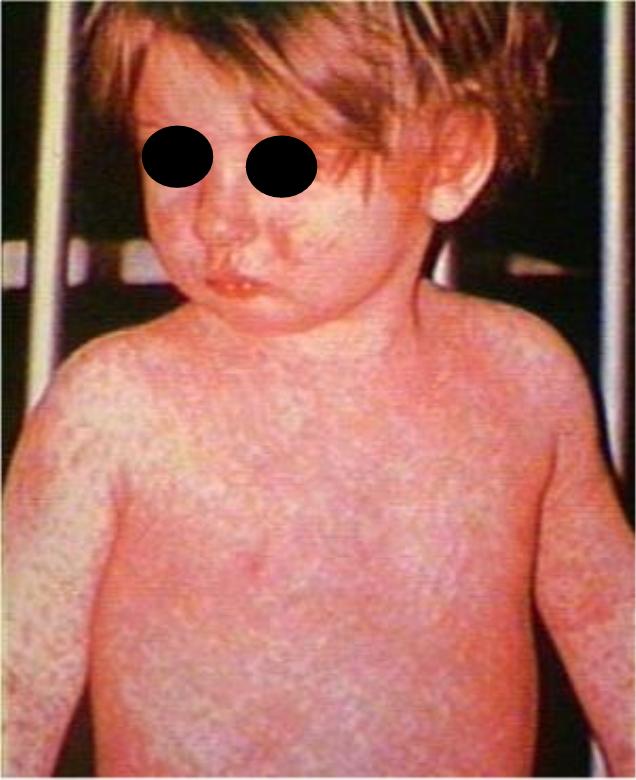Measles (Rubeola,
Morbilli, 9-Day Measles)
 Measles is a very contagious viral illness with fever, cough, nasal
congestion, characteristic rash, and irritation of the mucous membranes (Koplik's
spots). Measles is a very contagious viral illness with fever, cough, nasal
congestion, characteristic rash, and irritation of the mucous membranes (Koplik's
spots).
There is a 7-10 day incubation period following exposure. The initial
symptoms are flu-like, with nasal itching, fever, dry hacky cough and
inflammation of the conjunctiva.
-
2-4 days later, Koplik's spots appear. These look like white grains
of sand, surrounded by raised, red areas on the inside of the mouth or
lips.
-
3-5 days after initial symptoms, the rash appears. These are raised,
red skin lesions, starting on the sides of the neck and spreading
downward over the next 24-48 hours to the trunk and ultimately to the
extremities. This head-downward spread is characteristic of the
disease.
At this stage, the host appears to be quite
ill, with high fever (up to 104), mild itching, coughing, and sensitivity
to light. After 3-5 days of discomfort, the fever goes away, the rash
rapidly disappears, and recovery is prompt.
In otherwise healthy individuals, there is a very low mortality rate,
and most complications are due to bacterial superinfections (particularly
streptococcal). This may include pneumonia, otitis medica or pharyngitis.
During the illness, the immune system is pre-occupied and reactivation of
latent diseases (eg TB) can occur.
In immunocompromised individuals, the disease may be more lengthy, the
risk of superinfection is increased, and the usually rare complications of
myocarditis, pericarditis, glomerulonephritis, coma and encephalitis are
increased. Also at risk are children less than 5 years old, and those with
Vitamin A deficiency.
It is spread by aerosol contamination from the nose or mouth in tiny
droplets. Infected individuals are contagious starting 4 days before the rash
appears and continuing until the rash disappears.A previous infection normally
confers life-time immunity. Nearly as effective is active immunization. Newborn
infants of mothers who are immune receive temporary, passive immunity from the
placenta, lasting the better part of the first year of life.

Measles is sometimes confused clinically with:
|
Rubella (German Measles) |
German measles has a much milder clinical
course with little or no fever, enlarged, tender lymph nodes behind the
ears and the back of the neck. It lasts a shorter period of time. |
|
Drug reaction |
While the rash of a drug hypersensitivity
reaction can resemble that of measles, with drug reactions the rash
usually appears everywhere at once, rather than progressing from the head
downward. Also, drug rashes often involve the palms and soles, while
measles usually does not. Further, there is usually no prodromal symptoms
of itchy nose, hacking cough, and very high fever. |
|
Scarlet fever |
While both can begin with fever and
pharyngitis, the Scarlet fever rash is quite different. |
|
Roseola |
This condition ordinarily occurs in children
under the age of 3. The rash can be similar to that of measles, but the
rash of Roseola usually appears just as the fever is going away. Koplik's
spots are seen in measles, but not in Roseola. |
Immunization is with a weakened form of the virus which leads to a clinically
mild (or absent) illness that is not contagious. In fewer than 5% of
individuals, a temperature of 101 degrees and rash develop 5-12 days after
immunization. Immunization should not be done to pregnant women,
immunocompromized individuals, or those with widespread malignancy. Those
already exposed may be immunized, but this should be within 2 days of exposure
to be effective.
Treatment is generally supportive, but Vitamin
A, 400,000 IU orally seems to
reduce the morbidity and mortality of the illness, particularly in malnourished
or undernourished populations.
|


 Measles is a very contagious viral illness with fever, cough, nasal
congestion, characteristic rash, and irritation of the mucous membranes (Koplik's
spots).
Measles is a very contagious viral illness with fever, cough, nasal
congestion, characteristic rash, and irritation of the mucous membranes (Koplik's
spots).